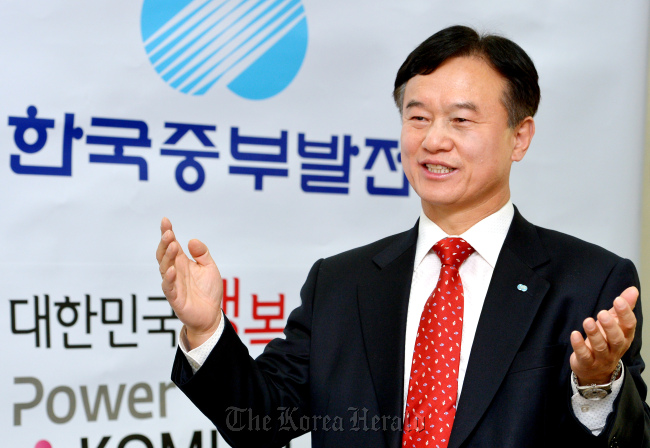This is the second in a series of case studies on the nation’s leading state-run companies which have made success stories overseas. ― Ed.
The Korea Midland Power Co., or KOMIPO, has big plans, seeking to emerge as a global brand for power generation by 2020.
“I am confident that the successful launch of a power plant in the fast-growing Indonesian power generation market last year will lay the foundations for the company’s drive for overseas expansion,” KOMIPO CEO Choi Pyeong-rak told The Korea Herald.
The Korea Midland Power Co., or KOMIPO, has big plans, seeking to emerge as a global brand for power generation by 2020.
“I am confident that the successful launch of a power plant in the fast-growing Indonesian power generation market last year will lay the foundations for the company’s drive for overseas expansion,” KOMIPO CEO Choi Pyeong-rak told The Korea Herald.

KOMIPO, one of six power generation subsidiaries of the state-run Korea Electric Power Corp., launched the first unit of a coal-fired thermal power plant with a production capacity of 660 megawatts in Cirebon, West Java, Indonesia, after three years of construction. The power plant will supply electricity to Bali and Java for the next 30 years.
“The Cirebon project is not the company’s first overseas business, but the project was meaningful in that it gave the company a chance to learn the whole process for an overseas power plant project ― from business development, project financing and construction, to operations and maintenance,” Choi said.
When it comes to overseas power plant projects, KOMIPO and other Korean power generators had previously engaged in technology transfer, plant construction, or O&M sectors separately.
“Partnership with local public or private companies in each process could be a model for the company’s future overseas business development,” he said.
For the Cirebon project, on top of a global partnership with Japan-based Marubeni for financing, KOMIPO formed a partnership with the state-run Korea Eximbank for further financing, Doosan Heavy Industries for plant construction and Samtan for the stable fuel supply to run the power plant. Samtan, a Korean energy company, runs a coal mine in Paser, Indonesia, under the corporate name of KIDECO. In Indonesia, KOMIPO also runs Units 3 and 4 of the Tanjung Jati thermal power plant. The two units’ power generation capacity is 660 megawatts each. If electricity generated by the Cirebon power plant is combined, KOMIPO is responsible for supplying about 10 percent of the electricity on Java, the fifth-largest island of Indonesia.
KOMIPO has looked beyond thermal power plants, and entered another renewable power generation project in Indonesia in 2009. It will launch a hydro power plant there with a capacity of 45 megawatts in Wampu, Sumatera, in 2015.
Vision for overseas business expansion
KOMIPO is a front-runner in expanding overseas businesses among six power generation subsidiaries of KEPCO. As of January 2013, the company runs six power generation projects overseas and is developing three new projects, including one for a 500-megawatt-class hydroelectric power plant in Pakistan.
“One of the reasons why KOMIPO is able to spur overseas business is simply because of people,” Choi said.
When six power generation companies were split from KEPCO as part of the restructuring of the nation’s power industry in 2001, KOMIPO secured a more talented workforce in the overseas business division at KEPCO than other power generation subsidiaries.
Another strength of KOMIPO comes from an edge over technology in power plant construction and O&M.
KOMIPO runs five thermal power plants in Korea, including the Boryeong Thermal Power Complex, which is the nation’s biggest thermal power site, and the Seoul Thermal Power Plant, the nation’s first thermal power plant built in 1930. Electricity generated by those five plants covers about 11 percent of the nation’s total electricity supply.
“Unit 3 of the Boryeong Thermal Power Complex boasts of trouble-free operation for 4,700 days,” Choi said.
KOMIPO also recently received a green light from the government for a project to build the world’s first underground thermal power plant in Mapo, western Seoul, which will replace the oldest Seoul Thermal Power Plant after its retirement in 2017.
“Despite continuously rising power demand in Korea, the local electricity market has already entered maturity. KOMIPO has no choice but to tap overseas markets for future growth,” Choi said.
“KOMIPO set the long-term goal of expanding electricity generation capacity overseas up to 50 percent of the company’s total power generation capacity by 2020. To achieve the growth vision, the company will set its sights on emerging markets and renewable power generation projects overseas, coupled with thermal power projects.”
According to the company, sales of KOMIPO are expected to reach 5.4 trillion won ($5 billion) in 2012, a 10 percent increase from a previous year. Sales gained overseas are estimated to reach 140 billion won ($13 million) in the same period.
“Overseas sales are forecast to rise at a fast pace from the mid-2010s, based on progress in overseas projects,” Choi said. “Power is essential not only for industrial development of a nation, but for advancing people’s quality of life. KOMIPO hopes not only to fuel industrial development, but also to light up the dreams of people at home and abroad.”
By Seo Jee-yeon (jyseo@heraldcorp.com)







![[Graphic News] More Koreans say they plan long-distance trips this year](http://res.heraldm.com/phpwas/restmb_idxmake.php?idx=644&simg=/content/image/2024/04/17/20240417050828_0.gif&u=)
![[KH Explains] Hyundai's full hybrid edge to pay off amid slow transition to pure EVs](http://res.heraldm.com/phpwas/restmb_idxmake.php?idx=644&simg=/content/image/2024/04/18/20240418050645_0.jpg&u=20240419100350)





![[From the Scene] Monks, Buddhists hail return of remains of Buddhas](http://res.heraldm.com/phpwas/restmb_idxmake.php?idx=652&simg=/content/image/2024/04/19/20240419050617_0.jpg&u=20240419175937)

![[KH Explains] Hyundai's full hybrid edge to pay off amid slow transition to pure EVs](http://res.heraldm.com/phpwas/restmb_idxmake.php?idx=652&simg=/content/image/2024/04/18/20240418050645_0.jpg&u=20240419100350)

![[Today’s K-pop] Illit drops debut single remix](http://res.heraldm.com/phpwas/restmb_idxmake.php?idx=642&simg=/content/image/2024/04/19/20240419050612_0.jpg&u=)